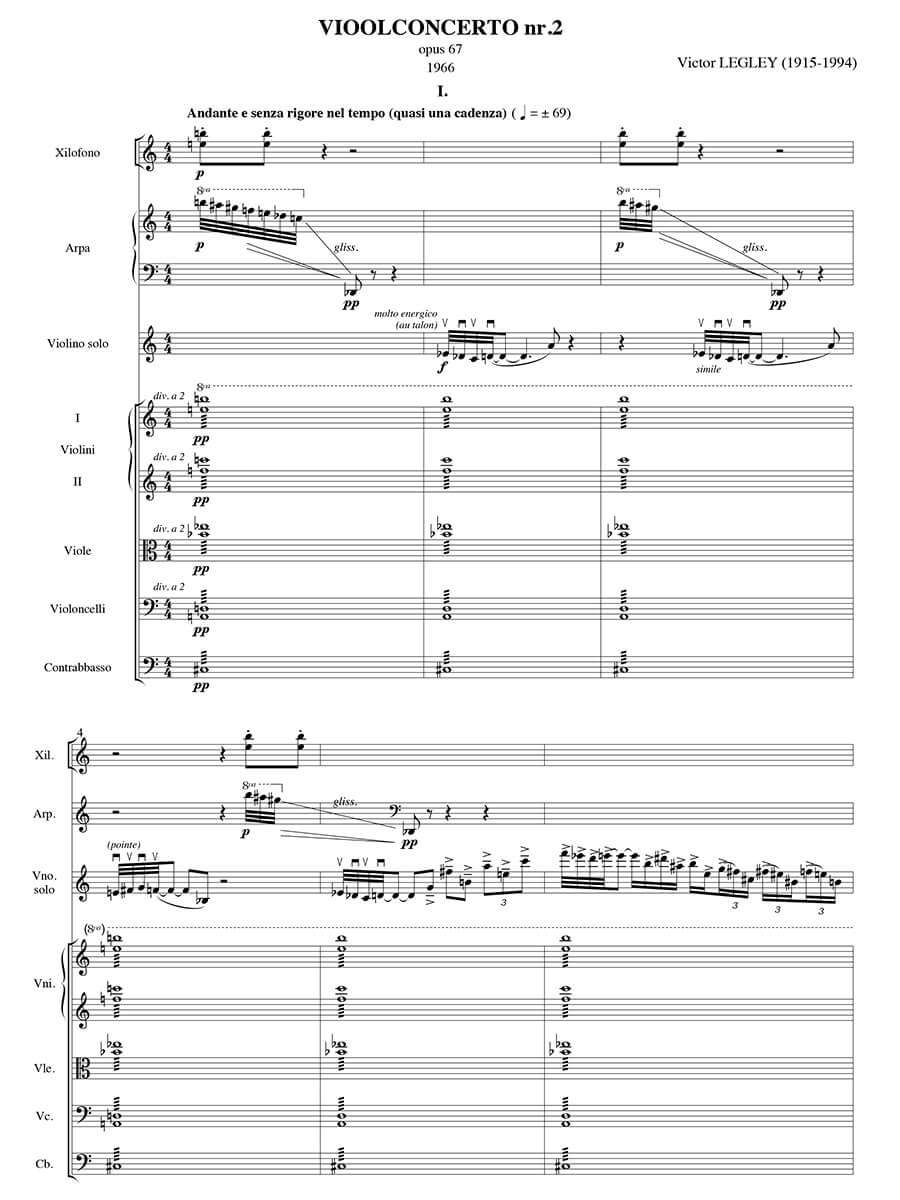Violin Concerto No. 2, Op. 67 (first print)
Legley, Victor
26,00 €
Victor Legley
(Hazebrouck, 18 June 1915 – Ostend, 28 November 1994)
Violin concerto No. 2, op. 67
(1966)
Belgian composer Victor Legley (1915-1994) composed his second violin concerto in 1966 as a compulsory work for the violin edition of the International Queen Elisabeth Competition of 1967. At the time, he had already written concertos for different instruments: for violin (1947), for piano (1952-1959), for timpani (1956) and for harp (1966), and in addition also a concerto for 13 instruments (1944).
It was the Belgian violinist Marjeta Delcourte-Korosec who had the honour of performing Legley’s second violin concerto for the first time, during the final of the aforementioned competition on 22 May 1967 at the Centre for Fine Arts in Brussels. She was accompanied by the National Orchestra of Belgium, conducted by René Defossez. The concerto was performed again that same week by the other finalists of the competition, among whom Gidon Kremer (third prize) and Philippe Hirschhorn (first prize).
The work is written for violin solo and a modest symphonic orchestra (2 flutes, 2 oboes, 2 clarinets, 2 bassoons, 2 horns, 2 trumpets, 2 trombones, percussion, harp and strings) and demonstrates a great influence by Béla Bartok’s music. Legley greatly admired the Hungarian composer and as a violist he had played in the orchestra of the Belgian Radio when Bartók concertized with it.
The first movement begins with a mysterious introduction (Andante e senza rigore nel tempo – quasi una cadenza) which already announces the first main theme and quickly evolves into the Allegro. This Allegro was written in a free sonata form, of which mostly the first theme with its variation of whole and half tones is clearly inspired by Bartók. The part ends with a cadenza for violin, followed by a virtuoso coda in which the orchestra reappears.
The following movement (Quasi adagio) is a lyrical part in the form of a Lied in which the violin takes up a dialogue with the orchestra. At times, the orchestra comments on the violin, at other times, the soloist remains more modest to clear the way for the orchestra: in bar 43 et seq. for example the violin plays musical arabesques in the background while in the orchestra a canon develops between cellos and double basses on the one hand and trumpet on the other.
The finale (Allegro risoluto ma non troppo vivace) is a rondo in which a dazzling chorus alternates with lyrical episodes. Right before the very last big outburst, Legley briefly freezes time with a reference to the introduction of the first movement (bar 127 et seq.) At the very end (starting at bar 193) of the following outburst, Legley reprises the final formula of the first movement to add a powerful ending to the work.After this concerto, Legley would go on to many other concertant works: for viola (1971), for alto saxophone (Concert d’automne, 1971-1974), for violin and alto saxophone (Concerto grosso, 1975-1976), for oboe (1982), for cello (1983-1984) and finally a third concerto for violin (Concert d’Awenne, 1990).
This concerto, the second for violin and orchestra, takes 20 to 25 minutes.Koenraad Sterckx (translation: Jasmien Dewilde)
This score was published in collaboration with the Study Centre for Flemish Music (www.svm.be). Orchestra material is available through the library of the Royal Conservatoire of Brussels (bib.kcb@ehb.be). Koenraad Sterckx edited the score based on the autograph. Critical comments can be consulted on http://wiki.muziekcollecties.be
Read full Flemish preface > HERE
| Special Edition | The Flemish Music Collection |
|---|---|
| Genre | Solo Instrument(s) & Orchestra |
| Performance Materials | available |
| Size | 225 x 320 mm |
| Printing | First print |
| Pages | 70 |
